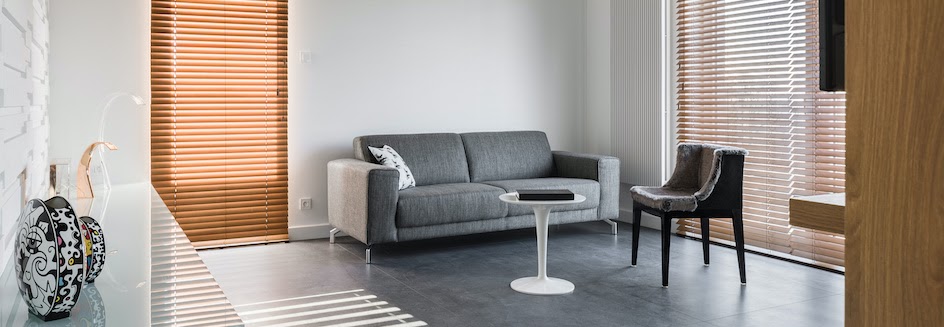Measuring and installing blinds can seem intimidating. Just the thought of it invokes visions of someone tottering on a stool and power tools flying. Fortunately, the reality is that it’s much easier to install blinds than you may think, especially when you have a step-by-step guide to follow.
Here, we’ve created a handy guide to help you measure and install venetian blinds. You’ll learn the basics of ventian blinds, measuring techniques and how to fit venetian blinds. With our numbered instructions, you’ll have your new blinds mounted in a matter of minutes. The best part? You’ll even find a venetian blind option that can be installed without using any power tools.
What Are Venetian Blinds?
Venetian blinds are a type of window treatment made with horizontal slats that are hung from ladder cords. The blinds move up and down via a corded mechanism and also feature a tilt wand that can adjust the slats 180 degrees to allow for greater light control. Since they also tilt in addition to moving up and down, they offer a larger range of privacy and light options. These blinds are also known as wooden blinds or aluminium venetian blinds.
Venetian blinds are made from real wood, faux wood, PVC and metals like aluminium. They come in a range of stains and colours including white, black, mahogany and cedar. These blinds are a popular choice for bedrooms and living rooms as they add a natural touch. Faux wood, PVC and aluminium varieties can also be used in wet spaces such as bathrooms and kitchens without warping.
The extensive light control benefits also make them useful in offices, classrooms and other spaces where the light causes glare in different areas throughout the day. While the blinds create a dark atmosphere when closed, they still allow a small amount of light seepage between the individual slats. They don’t offer total darkness compared to other blackout blinds, but are still well-suited for rooms like theatres and nurseries.
How To Measure Venetian Blinds
So you’re thinking about ordering venetian blinds and aren’t sure which size to order. At Make My Blinds, all of our blinds are custom cut to provide a perfect fit regardless of your window size. To get a seamless look, you’ll need to measure the dimensions of your window frame before ordering venetian blinds. Before you can do that, you have to decide how you want to mount your venetian blinds.
There are two ways to mount blinds: inside the recess or outside the recess. Inside the recess involves mounting your blinds to the bottom of the lintel — the wood or metal support that is located above window frames and doorways. This type of mount is the most common and offers a seamless look. That’s because the blinds sit directly inside the window recess, without any parts overlapping.
Outside the recess involves installing the blinds outside the frame, meaning it will overlap on the sides and top. This type of mount is ideal for windows with arrow ledges or those with large handles that may obstruct the operation of the blind.
You can also choose to do a top fix or face fix mount. A top fix mount is only possible with inside the recess fittings as you attach the blind headrail directly to the top of the window frame. A face fix mount can be used both inside and outside the recess. With this style, you attach the headrail directly to the frame of the window or wall facing into the room.
Once you decide how you want to mount, measuring is quick and easy. Plus, you’ll only need a few tools: a tape measure, a pencil and a piece of paper. Here’s how to measure venetian blinds.
Inside the Recess
The measuring instructions can be used for all types of venetian blinds whether they’re made of wood, aluminium or other material. Here’s how to measure.
1. Inside the recess of your window, measure the width from one wall to the other. You’ll do this in three places: across the top, middle and bottom. Write down the smallest measurement.
2. Make sure to measure outside of any obstructions such as tiles or picture rails.
3. Measure the drop, or height, of the window across the left, middle and right. Write down the smallest measurement.
4. When ordering your new blinds, select “recess” as your fit option and enter your measurements.
For all of our venetian blinds, we deduct 12 millimetres from the width to allow room for the control mechanism. You’ll also get a matching valance that is cut to your dimension to cover the headrail.
Outside the Recess
For exact blind measurements, also known as outside the recess, you’ll need to decide where to mount the blinds. The blind should overlap the window symmetrically. Typically, we recommend an overlap of at least 35 millimetres on each side in order to completely cover the window recess.
1. Measure and mark the desired position of the venetian blind.
2. Measure the width between the two marks and write it down on your paper.
3. Measure the height of your window recess from the point where you want the headrail to sit down to where you want the bottom to stop — typically at the bottom of the windowsill.
4. Select “exact” fit when ordering your blinds and enter your measurements.
For this type of mount, we don’t deduct any amount from your measurements. The brackets will add 3 millimetres to the measurements given and you’ll receive a colour-matched valance that is slightly larger than the blind. It also includes side returns to cover the end of the headrail.
How To Fit Venetian Blinds
Now that you’ve measured and ordered your venetian blinds, it’s time to get them installed. This process will take just a few minutes. You’ll need a screwdriver, a drill and appropriate size drill bit, tape measure, pencil, screws, brackets and wall plugs. Here’s a step-by-step guide on how to fit venetian blinds including how to install child safety features. Our blinds adhere to the British Blind and Shutter Association guidelines and include a safety cleat that prevents young children and pets from getting tangled up in the blind cords.
1. Position the blind on the wall and mark the holes where you‘ll mount the brackets. Again, you can mount it as a top fix on the lintel or face fix on the window frame for inside the recess mounts. If you’re mounting the blinds outside the recess, you’ll mark bracket holes on the face of the wall.
2. Drill the holes you marked and insert the wall plugs.
3. Place the bracket over the holes and use a screwdriver to tighten the screws. Repeat for the second bracket.
4. Turn the swing arms on the brackets so that they face you.
5. Take the top rail of the blind and snap it into place by turning the swing arm back towards the mount.
6. Install the optional hold down clips to the window/wall facing or window recess and pop the bracket pin ends to the bottom rail end.
7. Position the safety cleat as close to the top rail as possible and no less than 1500 millimetres from the floor. Mark and drill the screw holes before tightening the screws using a screwdriver. Wrap the cord around the cleat in a figure eight, making sure they are secure.
Hang Venetian Blinds Without a Drill
Don’t feel like using a drill and hardware to mount your blinds? Take a look at our Perfect Fit venetian blinds. Perfect Fit blinds don’t require any drilling or tools as they mount directly to the window frame using a bracket that goes between the glass and the rubber glazing strip on your UPVC windows. That means you can install them without having to pull out your tool bag or making a special trip to Homebase or B&Q to buy new tools.
You simply slip the bracket into place between the rubber and glass. Then snap them into place — and voila — your new blinds are up and ready to use. These venetian blinds come in a white or anthracite frame to match the colour of your UPVC window frames. Our a href="/blinds/perfect-fit/">Perfect Fit blinds come in a huge range of colours, plus you’ll find honeycomb styles made of fabrics as well as faux wood, real wood and aluminium blinds.




